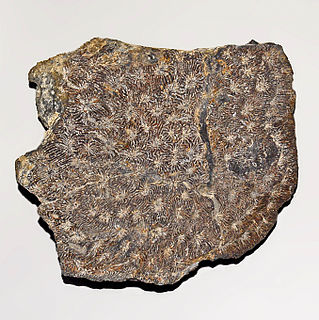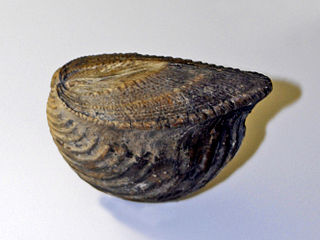 W
WSeveral stratigraphic units in Colombia have provided fossils. The richest formations are the Devonian Cuche and Floresta Formations, the Cretaceous Paja Formation, the Paleocene Cerrejón Formation and the Miocene La Venta site. The latter is the richest Konzentrat-Lagerstätte in northern South America and comprises the formations of the Honda Group.
 W
WThe Arcabuco Formation is a geological formation of the Altiplano Cundiboyacense, Eastern Ranges of the Colombian Andes. The formation consists of thick beds of light-coloured quartzitic sandstones and conglomerates with occasional shales and dates to the Late Jurassic and Early Cretaceous periods; Tithonian to Berriasian epochs. Dinosaur footprints have been found in the Arcabuco Formation near the Iguaque anticlinal outside Chíquiza, Boyacá.
 W
WCladophlebis is an extinct form genus of fern, used to refer to Paleozoic and Mesozoic fern leaves that have "fern fronds with pinnules that are attached to the rachis, and have a median vein that runs to the apex of the pinnule, and veins from that are curved and dichotomise". By convention this genus is not used to refer to fossil ferns from the Cenozoic. Ferns with this morphology belong to several families, including Osmundaceae, Dicksoniaceae and Schizaeaceae. Ferns with this morphology are common during the Paleozoic and Mesozoic in both the northern and southern hemispheres.
 W
WThe Girón Formation is an extensive geological formation stretching across 325 kilometres (202 mi) from the north in Teorama, Norte de Santander, across the Mesa de Los Santos and Chicamocha Canyon towards west of Nobsa, Boyacá in the northern part of the Altiplano Cundiboyacense in the south. The formation extends across the northern and central part of the Eastern Ranges of the Colombian Andes.
 W
WThe Guavio Formation is a geological formation of the Altiplano Cundiboyacense, Eastern Ranges of the Colombian Andes. The formation consists of conglomerates, shales and limestones, dates to the Late Jurassic and Early Cretaceous periods; Tithonian to Berriasian epochs and has a maximum thickness of 1,000 metres (3,300 ft).
 W
WIsastrea is an extinct genus of corals that lived during the Jurassic and Cretaceous periods. Its fossils have been found in Europe, Africa, North America, Asia and South America.
 W
WThe La Quinta Formation is a Jurassic geologic formation which crops out in the Cordillera de Mérida and Serranía del Perijá of western Venezuela and northeastern Colombia. The formation is also present in the subsurface of the Cesar-Ranchería and Maracaibo Basins. At its type locality near La Grita, Táchira, it consists of a basal dacitic tuff followed by interlayered sandstones, tuffs, siltstones and rare limestones. Dinosaur remains including Laquintasaura, and Tachiraptor, are among the fossils that have been recovered from the formation.
 W
WThe Noreán Formation is a geological formation of the Eastern Ranges of the Colombian Andes, the Serranía de San Lucas and as basement underlying the southernmost Lower and northern Middle Magdalena Valleys. The formation consists of volcanic and pyroclastic lavas that range from andesites to rhyolites. Vitric, lithic and crystal tuffs and andesitic dikes and hypabyssal bodies are also present in the formation.
 W
WPholadomya is a genus of saltwater clams, marine bivalve molluscs in the family Pholadomyidae.
 W
WSagenopteris is a genus of extinct seed ferns from the Triassic to late Early Cretaceous.
 W
WSphenopteris is a genus of seed ferns containing the foliage of various extinct plants, ranging from the Devonian to Late Cretaceous.
 W
WThamnasteria is an genus of extinct stony corals.
 W
WTrigonia is an extinct genus of saltwater clams, fossil marine bivalve mollusk in the family Trigoniidae. The fossil range of the genus spans the Paleozoic, Mesozoic and Paleocene of the Cenozoic, from 298 to 56 Ma.
 W
WThe Valle Alto Formation is a geological formation of the Central Ranges of the Colombian Andes. The formation is composed of shales, sandstones and conglomerates and dates to the Late Jurassic period. Ammonites and fossil flora have been found in the Valle Alto Formation.
 W
WZamites is a genus of fossil tree known from the Mesozoic of North America, Europe and India through the Eocene of North America. It is a form taxon for leaves that resemble the extant cycad Zamia. The fronds are linear or lanceolate in shape, and pinnately compound, with pinnae with parallel veins and smooth margins, and symmetrical and constricted at the base where they are attached obliquely to the upper surface of the rachis. It has been interpreted as a cycad in the family Cycadaceae or a Bennettitalean plant.